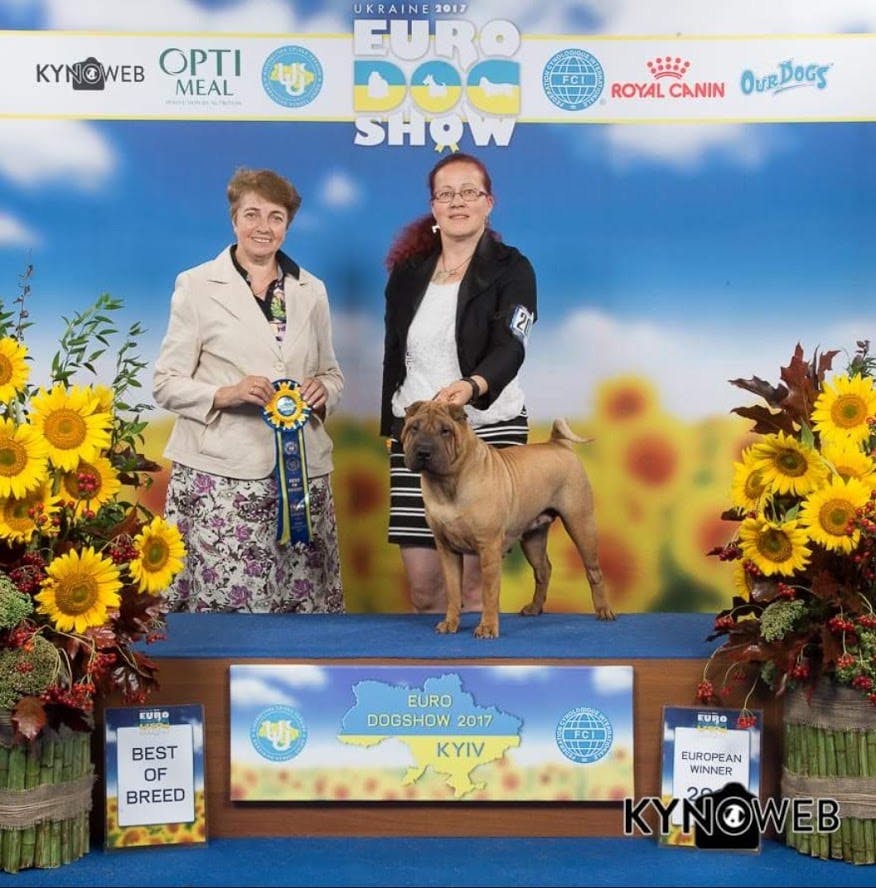Interview with Elena Kuleshova

Elena Kuleshova is an FCI International All Breeds judge and a Shar Pei breeder since 1991. Her kennel is named “Nevskiy Han”. In her professional life she is a biologist - zoologist.
You have a very long history with the Shar Pei. Could you tell us how and when you got in contact with the breed?
My first dog was a East-European shepherd in 1975. Not for breeding, only for training. Later, in 1982, I had Rottweilers. I trained them for guard work.
In 1987 I got the book “ Encyclopedia of dogs”. In there I saw the breed of Shar Pei for the first time.
In 1990 I was invited by the American Rottweiler Club for a Jubilee Rottweiler Specialty Show . During this trip I had the chance to meet many judges, breeders and other dog people. I was very interested to study the Shar Pei. I visited a few Sharpei kennels in different parts of the US. It was an excellent experience and learning period for me.
In 1991 I got my first two Shar Pei, a male and a female from Sunoak’s kennel in Ohio. They were shown at many dog shows at that time. In 1993 I visited the US with both of my Shar Pei and participated in some National Shar Pei Specialties. At that time I became acquainted with many responsible breeders . I studied the Shar Pei more and more. It was a very interesting and useful time. During that trip I got four Shar Pei puppies from Wanson kennel and R-Lee kennel. Back in Russia, I registered my own kennel in CSPCA under the prefix O’HAN. Then I changed the name of my kennel as ‘ Nevskiy Han” in FCI.
What do you like most about the breed?
There are many Shar Pei features I like. Their temperament is really unique. I like their obedience, independence and loyal character. They are very trainable in sport. I like their balanced muscular body, their unique quality hard short coat, their harmonious head with their unique and special expression. I also like their strong movement and jumping qualities.
Can you tell us a little bit about the history of Shar Pei in Russia? When and where did the first Shar Pei come from in Russia?
The history of the breed in Russia is very sad. Because it was mostly only for business. Sharpeis were very popular in the middle of 1990s everywhere In Russia and in Europe. There are no reliable informations about the appearance of the first Shar Pei in Russia at the end of the 1980s. I know the first registered Shar Pei was coming from the US to Saint Petersburg in 1990. He was from “ Imperial’s” kennel. It was a cream colored horse coat male. Then I got two Sharpeis in 1991 from the US to Saint Petersburg. They were a horse coat cream female and a fawn male of “Sunoak’s” kennel. All this 3 dogs had CSPCA pedigrees. In 1992 we had the first AKC pedigrees for Shar Pei.
You are not only a respected FCI judge, you are also a breeder. What do you find most challenging for Shar Pei breeders?
Most challenging for Shar Pei breeders? It is not a simple question. In my opinion breeders should be more educated of the Shar Pei as a breed. They have to put in mind the health of their Sharpeis. So the different tests are necessary, for the studs and bitches to get all the health information we can. Some of the health tests are available now even in Russia. Also it would be great if there would be more support amongst the breeders.
Knowing the breeds standard is not only essential for a judge, but also for a breeder. Often standards leave room for wider interpretations and misinterpretations. How can we prevent misinterpretations when reading a standard?
To prevent misinterpretations when reading the standard, breeders and judges should cerefully study anatomy, conformations and the history of the breed. Only correct knowledge of the Shar Pei will help to understand the standard.
Today we have many tools at hand, like different health tests. How important are they for breeders and how should test results affect our breeding plans?
In my opinion the health tests are very important for the breed. Of course it helps with our breeding plans because it’s necessary to know the health variations of the livestock. The worldwide Shar Pei population is very diverse. From the 1960s until today the Shar Pei as a breed had changed too much. In regard of general appearance and health. Breeders should know the basics of genetics to select correct Shar Pei for breeding.
What are your hopes and wishes for the breeds future?
My wishes for the breed in future. In my mind the name of the breed should be Chinese Shar Pei . The FCI Standard Commission should specify Shar Pei Standard more clearly such as in the coat part, head part and other part of conformation. May be it makes sense to move the Shar Pei in group 5 in FCI nomenclature. The breed of Shar Pei is not really a molossian. The Shar Pei is a natural breed. They are more closer to the primitive typse and hunting breeds such as Thai Ridgebacks, Taiwan Dogs and others in that group. Maybe the breed would be understood much better if it were in the correct group.
For breeding, I believe we should take advantage of the gene pool of the dogs from China. It may improve our breeds health and maybe we could correct some of the mistakes that were done in the past.
Thank you Elena Kuleshova for this interview.



